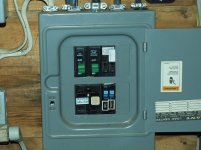muddstopper
Veteran Member
Mud, could you re-state this sentence. It is confusing to me. The way it possibly reads is that I'm connecting the neutral to a positive busbar which is opposite to the existing positive busbar? Then run a ground wire from the shop box ground where the ground used to be to a grounding rod? Correct? I already have two 30 amp breakers in the house connected to the 10 wire out to the garage. (why did the guy put in two 30 amp breakers and not one if its 115v)
Quote Originally Posted by muddstopper View Post
In you shop breaker box, you would take the Neutral (white wire) off the ground busbar and connect to the opposite (Positive) busbar than the one the Positive, (black wire) is hooked to.
Just to clear up what I wrote earlier, not to make an argument that this is the correct way to do this.
Your current wire setup is #10 wire buried to your shop. You wire has a black wire, a white wire, and a bare ground wire. In you current setup, your white wire is being used as a neutral wire and is connected to the ground strip in your house as well as your shop breakerbox. If your breaker box is setup to accept 220v, it should have 2 strips for positive current and a ground strip. By removeing the white wire from the ground strip in your house breaker box, as well as the shop breakerbox, you can then attach each end of the white wire to the second positive bar in each breaker box and make the white wire a positive wire instead of a neutral. The black wire should already be attached to the other positive bar. There is the possibility that inside your shop breaker box, the 2 positive strips are connected with a jumper so both bars are positive, but still only 110v current. If this is the case, the jumper wire must be removed before connecting the white wire to the positive terminal, otherwise you would create a serious short. Now once you have removed the white wire from the ground bar, you would connect another bare wire to the ground strip and connect the other end to a ground rod driven into the soil outside the shop. I suppose to get around the code requirement, you could always just run a extra insulated wire for neutral from your house to the shop
Disclaimer
I know this method will work to supply 220v to your shop, I havent had any problems in my shop wired this way for 30years. Still, codes are written and changed for a reason, so if you chose to do this, you do so at your own risk and I cannot be held responsible in the event something does happen. There seems to be a few folks here with quite a bit more knowledge on this subject than I have. I didnt wire my shop the way it is wired, it was that way when I bought the house.

